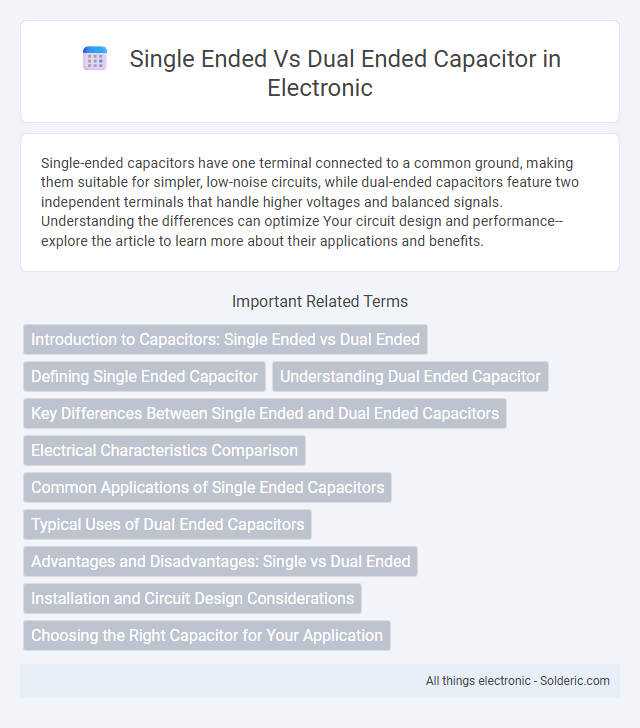Single-ended capacitors have one terminal connected to a common ground, making them suitable for simpler, low-noise circuits, while dual-ended capacitors feature two independent terminals that handle higher voltages and balanced signals. Understanding the differences can optimize Your circuit design and performance--explore the article to learn more about their applications and benefits.
Comparison Table
| Feature | Single Ended Capacitor | Dual Ended Capacitor |
|---|---|---|
| Terminal Configuration | One terminal connected; other terminal internally grounded or fixed | Two separate terminals for connection |
| Common Usage | Signal coupling, decoupling in low-voltage circuits | Power filtering, energy storage, and AC applications |
| Electrical Characteristics | Typically lower voltage rating | Higher voltage and current capacity |
| Complexity | Simple design and connection | More complex due to two-terminal configuration |
| Application Examples | Audio equipment, low-frequency circuits | Power supplies, motor drives, high-frequency circuits |
Introduction to Capacitors: Single Ended vs Dual Ended
Single ended capacitors feature one terminal connected to the circuit while the other terminal is grounded, making them ideal for noise filtering and signal coupling in simple designs. Dual ended capacitors have two terminals connected within the circuit, providing balanced signal handling and better performance in applications requiring stable capacitance and reduced electromagnetic interference. Understanding the differences between single ended and dual ended capacitors helps you select the right type for optimizing circuit functionality and reliability.
Defining Single Ended Capacitor
Single ended capacitors feature one terminal connected to a circuit node while the other terminal is grounded, commonly used for filtering and decoupling applications. This design simplifies integration and reduces parasitic inductance, making it ideal for high-frequency circuits. Understanding your circuit's requirements helps determine if a single ended capacitor provides optimal performance compared to dual ended options.
Understanding Dual Ended Capacitor
Dual ended capacitors feature two terminals allowing current to flow in both directions, unlike single ended capacitors which have one terminal connected to a fixed reference point. This configuration enhances stability and reduces noise in complex circuits such as audio amplifiers, RF modules, and power supply filtering. The bidirectional property of dual ended capacitors makes them essential for applications requiring balanced signal integrity and improved frequency response.
Key Differences Between Single Ended and Dual Ended Capacitors
Single ended capacitors feature one terminal connected to the circuit while the other terminal is grounded, making them suitable for simpler, low-frequency applications. Dual ended capacitors have two active terminals allowing for bidirectional current flow, enabling better performance in AC circuits and high-frequency filtering. Your choice depends on application requirements like signal type, frequency response, and circuit design complexity.
Electrical Characteristics Comparison
Single-ended capacitors offer simpler construction with a single lead connected to the circuit, resulting in lower parasitic inductance but potentially higher susceptibility to noise and interference. Dual-ended capacitors feature two terminals, providing better noise rejection, improved stability, and balanced electrical characteristics, making them ideal for differential signal processing. Your choice depends on the required performance in capacitance, impedance, and electromagnetic compatibility within your specific electronic application.
Common Applications of Single Ended Capacitors
Single ended capacitors are commonly used in audio signal processing to connect and filter individual components, such as in guitar pedals and amplifiers, where they isolate DC voltage while allowing AC signals to pass. Their simple design makes them ideal for low-frequency applications and decoupling tasks in power supplies, ensuring stable voltage levels. You will often find single ended capacitors in consumer electronics and instrumentation circuits due to their cost-effectiveness and reliability.
Typical Uses of Dual Ended Capacitors
Dual ended capacitors are commonly used in power supply filtering, signal coupling, and decoupling applications where stable, low-inductance performance is critical. They provide improved noise reduction and voltage stabilization in electronic circuits such as audio equipment, RF systems, and DC-DC converters. Their construction allows for enhanced reliability and efficiency in high-frequency and high-current environments compared to single ended capacitors.
Advantages and Disadvantages: Single vs Dual Ended
Single-ended capacitors offer simpler design and lower cost, making them suitable for applications requiring minimal noise and signal clarity. Dual-ended capacitors provide improved performance with better noise rejection and stability in high-frequency circuits but tend to be bulkier and more expensive. Choosing between single-ended and dual-ended capacitors depends on balancing cost, size, and the need for enhanced signal integrity in specific electronic applications.
Installation and Circuit Design Considerations
Single-ended capacitors require careful polarity alignment during installation to prevent circuit damage, making them suitable for DC applications. Dual-ended capacitors offer symmetric terminals, simplifying integration into AC circuits and reducing the risk of installation errors. Your choice between these types directly impacts circuit stability, layout flexibility, and overall performance optimization.
Choosing the Right Capacitor for Your Application
Selecting the right capacitor depends on the specific circuit requirements; single-ended capacitors are ideal for low-voltage, straightforward applications due to their simple design and ease of integration. Dual-ended capacitors provide enhanced stability and higher voltage tolerance, making them suitable for high-frequency or precision circuits where minimizing noise and interference is critical. Evaluating factors such as voltage rating, capacitance value, and signal integrity ensures optimal performance and longevity in your electronic design.
single ended vs dual ended capacitor Infographic

 solderic.com
solderic.com